Retail Sector: Analyzing Next Plc's Strategies in the UK
VerifiedAdded on 2023/01/13
|12
|3668
|53
Report
AI Summary
This report provides an in-depth analysis of Next Plc, a major player in the UK fashion retail sector. It begins with an introduction to retail and the company, followed by an examination of key changes in the UK fashion retail landscape. The report then delves into the micro environment, analyzing factors such as competition, consumer behavior, and competitor analysis, including Porter's Five Forces. A PESTLE analysis is also conducted to assess the macro-environmental factors impacting Next Plc. The report concludes by suggesting and discussing various strategies and tactics that Next Plc could employ to maintain and improve its market position, considering both social changes and competitive pressures. The analysis highlights the importance of adapting to consumer demands and leveraging technology to drive growth and profitability.
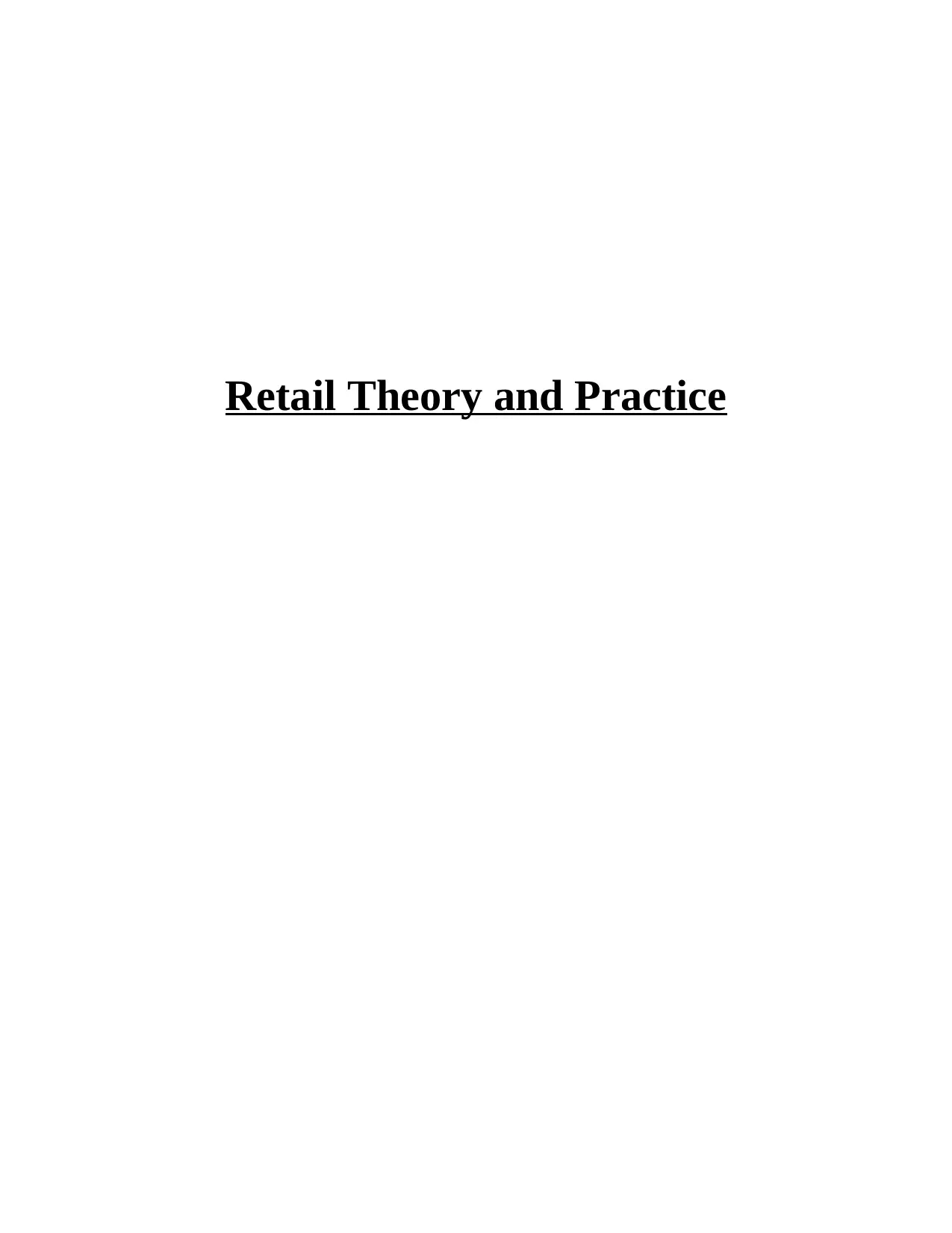
Retail Theory and Practice
Paraphrase This Document
Need a fresh take? Get an instant paraphrase of this document with our AI Paraphraser
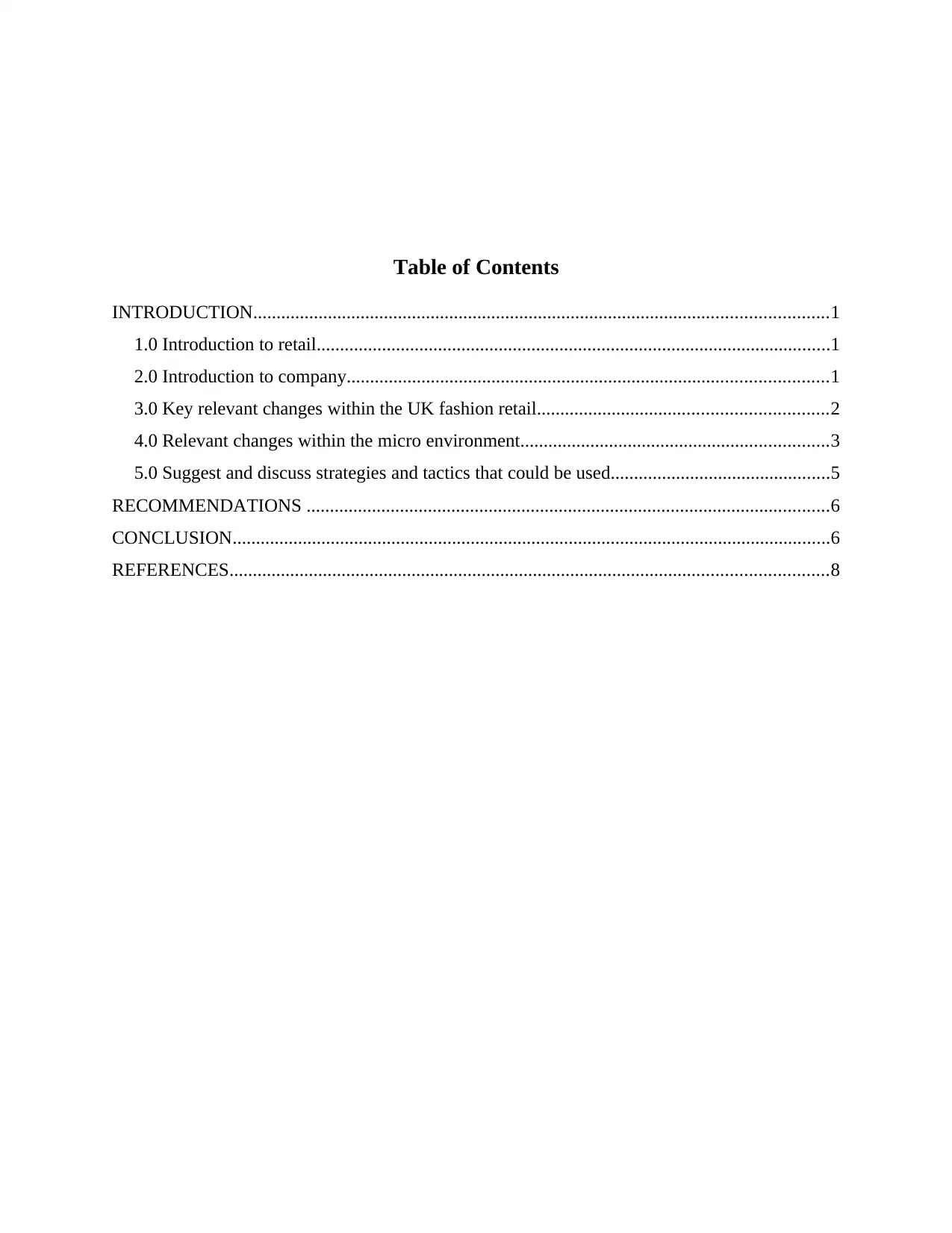
Table of Contents
INTRODUCTION...........................................................................................................................1
1.0 Introduction to retail..............................................................................................................1
2.0 Introduction to company.......................................................................................................1
3.0 Key relevant changes within the UK fashion retail..............................................................2
4.0 Relevant changes within the micro environment..................................................................3
5.0 Suggest and discuss strategies and tactics that could be used...............................................5
RECOMMENDATIONS ................................................................................................................6
CONCLUSION................................................................................................................................6
REFERENCES................................................................................................................................8
INTRODUCTION...........................................................................................................................1
1.0 Introduction to retail..............................................................................................................1
2.0 Introduction to company.......................................................................................................1
3.0 Key relevant changes within the UK fashion retail..............................................................2
4.0 Relevant changes within the micro environment..................................................................3
5.0 Suggest and discuss strategies and tactics that could be used...............................................5
RECOMMENDATIONS ................................................................................................................6
CONCLUSION................................................................................................................................6
REFERENCES................................................................................................................................8
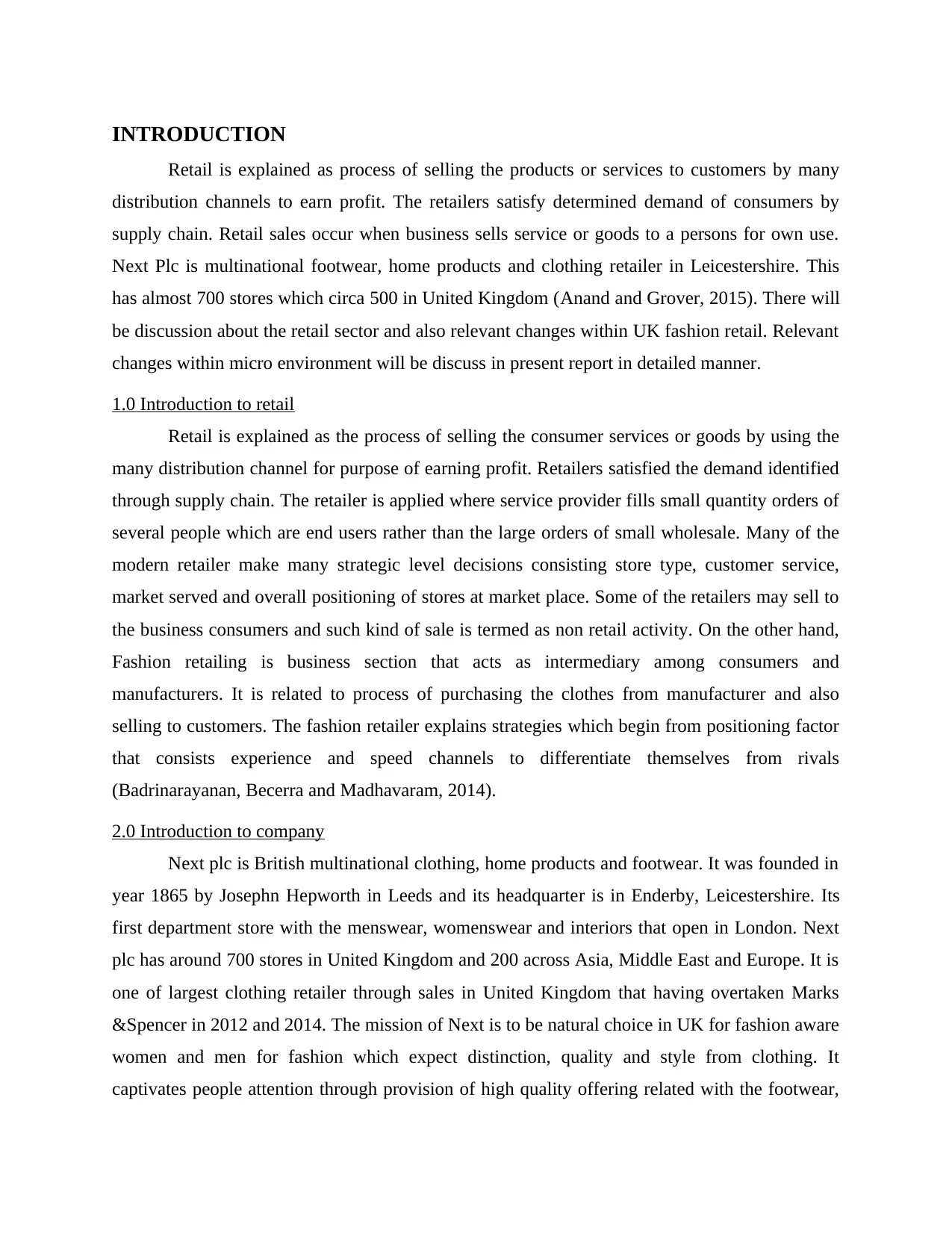
INTRODUCTION
Retail is explained as process of selling the products or services to customers by many
distribution channels to earn profit. The retailers satisfy determined demand of consumers by
supply chain. Retail sales occur when business sells service or goods to a persons for own use.
Next Plc is multinational footwear, home products and clothing retailer in Leicestershire. This
has almost 700 stores which circa 500 in United Kingdom (Anand and Grover, 2015). There will
be discussion about the retail sector and also relevant changes within UK fashion retail. Relevant
changes within micro environment will be discuss in present report in detailed manner.
1.0 Introduction to retail
Retail is explained as the process of selling the consumer services or goods by using the
many distribution channel for purpose of earning profit. Retailers satisfied the demand identified
through supply chain. The retailer is applied where service provider fills small quantity orders of
several people which are end users rather than the large orders of small wholesale. Many of the
modern retailer make many strategic level decisions consisting store type, customer service,
market served and overall positioning of stores at market place. Some of the retailers may sell to
the business consumers and such kind of sale is termed as non retail activity. On the other hand,
Fashion retailing is business section that acts as intermediary among consumers and
manufacturers. It is related to process of purchasing the clothes from manufacturer and also
selling to customers. The fashion retailer explains strategies which begin from positioning factor
that consists experience and speed channels to differentiate themselves from rivals
(Badrinarayanan, Becerra and Madhavaram, 2014).
2.0 Introduction to company
Next plc is British multinational clothing, home products and footwear. It was founded in
year 1865 by Josephn Hepworth in Leeds and its headquarter is in Enderby, Leicestershire. Its
first department store with the menswear, womenswear and interiors that open in London. Next
plc has around 700 stores in United Kingdom and 200 across Asia, Middle East and Europe. It is
one of largest clothing retailer through sales in United Kingdom that having overtaken Marks
&Spencer in 2012 and 2014. The mission of Next is to be natural choice in UK for fashion aware
women and men for fashion which expect distinction, quality and style from clothing. It
captivates people attention through provision of high quality offering related with the footwear,
Retail is explained as process of selling the products or services to customers by many
distribution channels to earn profit. The retailers satisfy determined demand of consumers by
supply chain. Retail sales occur when business sells service or goods to a persons for own use.
Next Plc is multinational footwear, home products and clothing retailer in Leicestershire. This
has almost 700 stores which circa 500 in United Kingdom (Anand and Grover, 2015). There will
be discussion about the retail sector and also relevant changes within UK fashion retail. Relevant
changes within micro environment will be discuss in present report in detailed manner.
1.0 Introduction to retail
Retail is explained as the process of selling the consumer services or goods by using the
many distribution channel for purpose of earning profit. Retailers satisfied the demand identified
through supply chain. The retailer is applied where service provider fills small quantity orders of
several people which are end users rather than the large orders of small wholesale. Many of the
modern retailer make many strategic level decisions consisting store type, customer service,
market served and overall positioning of stores at market place. Some of the retailers may sell to
the business consumers and such kind of sale is termed as non retail activity. On the other hand,
Fashion retailing is business section that acts as intermediary among consumers and
manufacturers. It is related to process of purchasing the clothes from manufacturer and also
selling to customers. The fashion retailer explains strategies which begin from positioning factor
that consists experience and speed channels to differentiate themselves from rivals
(Badrinarayanan, Becerra and Madhavaram, 2014).
2.0 Introduction to company
Next plc is British multinational clothing, home products and footwear. It was founded in
year 1865 by Josephn Hepworth in Leeds and its headquarter is in Enderby, Leicestershire. Its
first department store with the menswear, womenswear and interiors that open in London. Next
plc has around 700 stores in United Kingdom and 200 across Asia, Middle East and Europe. It is
one of largest clothing retailer through sales in United Kingdom that having overtaken Marks
&Spencer in 2012 and 2014. The mission of Next is to be natural choice in UK for fashion aware
women and men for fashion which expect distinction, quality and style from clothing. It
captivates people attention through provision of high quality offering related with the footwear,
⊘ This is a preview!⊘
Do you want full access?
Subscribe today to unlock all pages.

Trusted by 1+ million students worldwide
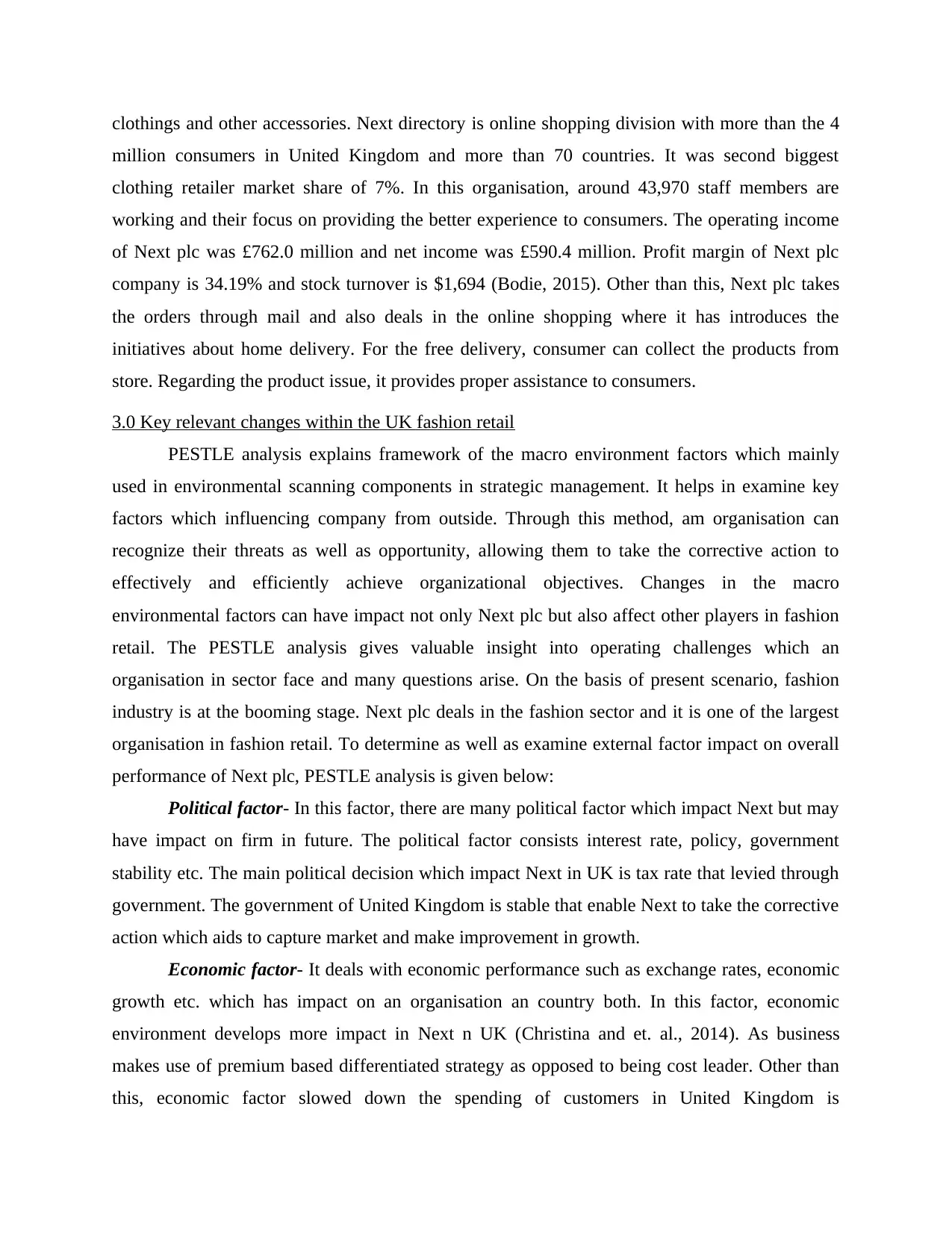
clothings and other accessories. Next directory is online shopping division with more than the 4
million consumers in United Kingdom and more than 70 countries. It was second biggest
clothing retailer market share of 7%. In this organisation, around 43,970 staff members are
working and their focus on providing the better experience to consumers. The operating income
of Next plc was £762.0 million and net income was £590.4 million. Profit margin of Next plc
company is 34.19% and stock turnover is $1,694 (Bodie, 2015). Other than this, Next plc takes
the orders through mail and also deals in the online shopping where it has introduces the
initiatives about home delivery. For the free delivery, consumer can collect the products from
store. Regarding the product issue, it provides proper assistance to consumers.
3.0 Key relevant changes within the UK fashion retail
PESTLE analysis explains framework of the macro environment factors which mainly
used in environmental scanning components in strategic management. It helps in examine key
factors which influencing company from outside. Through this method, am organisation can
recognize their threats as well as opportunity, allowing them to take the corrective action to
effectively and efficiently achieve organizational objectives. Changes in the macro
environmental factors can have impact not only Next plc but also affect other players in fashion
retail. The PESTLE analysis gives valuable insight into operating challenges which an
organisation in sector face and many questions arise. On the basis of present scenario, fashion
industry is at the booming stage. Next plc deals in the fashion sector and it is one of the largest
organisation in fashion retail. To determine as well as examine external factor impact on overall
performance of Next plc, PESTLE analysis is given below:
Political factor- In this factor, there are many political factor which impact Next but may
have impact on firm in future. The political factor consists interest rate, policy, government
stability etc. The main political decision which impact Next in UK is tax rate that levied through
government. The government of United Kingdom is stable that enable Next to take the corrective
action which aids to capture market and make improvement in growth.
Economic factor- It deals with economic performance such as exchange rates, economic
growth etc. which has impact on an organisation an country both. In this factor, economic
environment develops more impact in Next n UK (Christina and et. al., 2014). As business
makes use of premium based differentiated strategy as opposed to being cost leader. Other than
this, economic factor slowed down the spending of customers in United Kingdom is
million consumers in United Kingdom and more than 70 countries. It was second biggest
clothing retailer market share of 7%. In this organisation, around 43,970 staff members are
working and their focus on providing the better experience to consumers. The operating income
of Next plc was £762.0 million and net income was £590.4 million. Profit margin of Next plc
company is 34.19% and stock turnover is $1,694 (Bodie, 2015). Other than this, Next plc takes
the orders through mail and also deals in the online shopping where it has introduces the
initiatives about home delivery. For the free delivery, consumer can collect the products from
store. Regarding the product issue, it provides proper assistance to consumers.
3.0 Key relevant changes within the UK fashion retail
PESTLE analysis explains framework of the macro environment factors which mainly
used in environmental scanning components in strategic management. It helps in examine key
factors which influencing company from outside. Through this method, am organisation can
recognize their threats as well as opportunity, allowing them to take the corrective action to
effectively and efficiently achieve organizational objectives. Changes in the macro
environmental factors can have impact not only Next plc but also affect other players in fashion
retail. The PESTLE analysis gives valuable insight into operating challenges which an
organisation in sector face and many questions arise. On the basis of present scenario, fashion
industry is at the booming stage. Next plc deals in the fashion sector and it is one of the largest
organisation in fashion retail. To determine as well as examine external factor impact on overall
performance of Next plc, PESTLE analysis is given below:
Political factor- In this factor, there are many political factor which impact Next but may
have impact on firm in future. The political factor consists interest rate, policy, government
stability etc. The main political decision which impact Next in UK is tax rate that levied through
government. The government of United Kingdom is stable that enable Next to take the corrective
action which aids to capture market and make improvement in growth.
Economic factor- It deals with economic performance such as exchange rates, economic
growth etc. which has impact on an organisation an country both. In this factor, economic
environment develops more impact in Next n UK (Christina and et. al., 2014). As business
makes use of premium based differentiated strategy as opposed to being cost leader. Other than
this, economic factor slowed down the spending of customers in United Kingdom is
Paraphrase This Document
Need a fresh take? Get an instant paraphrase of this document with our AI Paraphraser
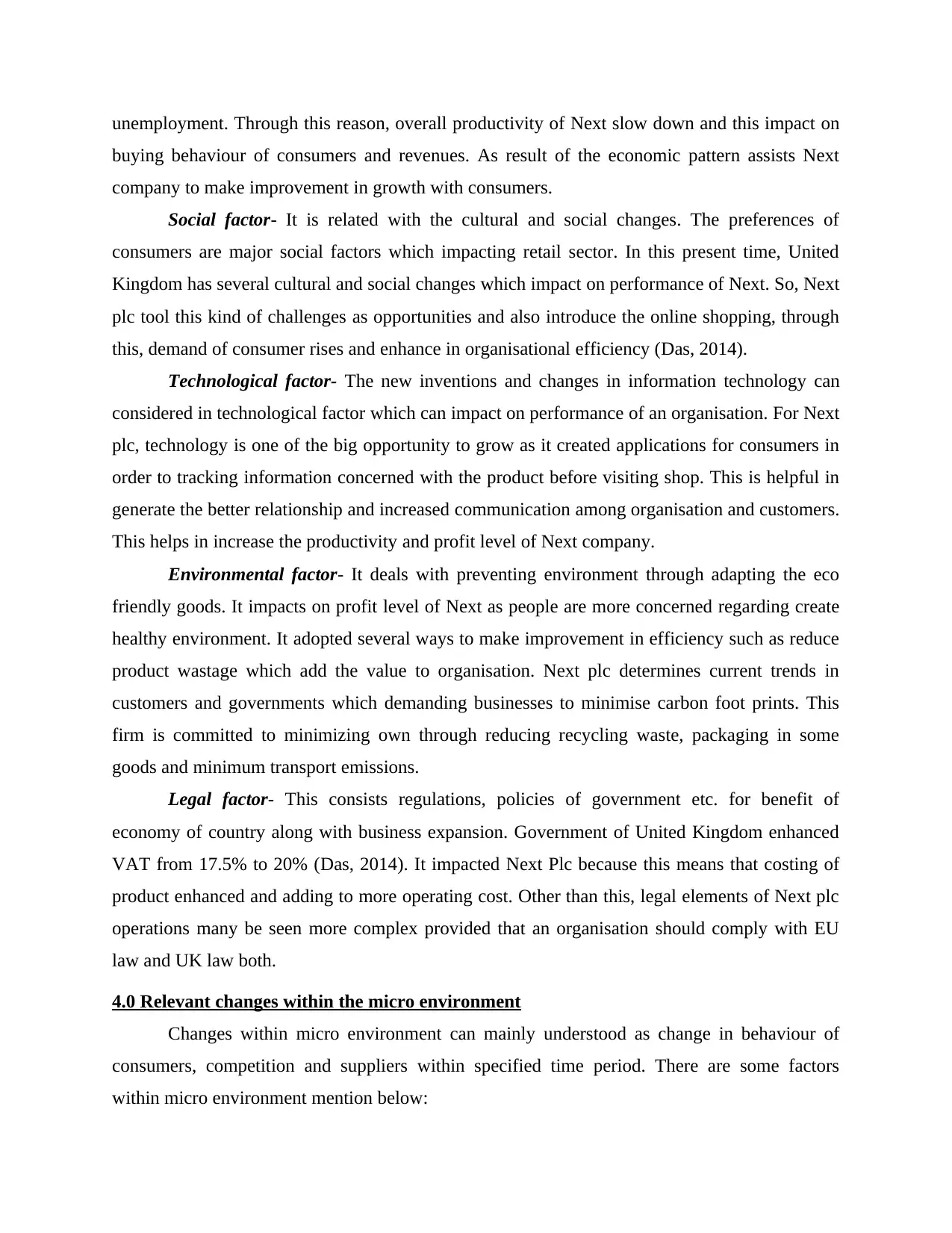
unemployment. Through this reason, overall productivity of Next slow down and this impact on
buying behaviour of consumers and revenues. As result of the economic pattern assists Next
company to make improvement in growth with consumers.
Social factor- It is related with the cultural and social changes. The preferences of
consumers are major social factors which impacting retail sector. In this present time, United
Kingdom has several cultural and social changes which impact on performance of Next. So, Next
plc tool this kind of challenges as opportunities and also introduce the online shopping, through
this, demand of consumer rises and enhance in organisational efficiency (Das, 2014).
Technological factor- The new inventions and changes in information technology can
considered in technological factor which can impact on performance of an organisation. For Next
plc, technology is one of the big opportunity to grow as it created applications for consumers in
order to tracking information concerned with the product before visiting shop. This is helpful in
generate the better relationship and increased communication among organisation and customers.
This helps in increase the productivity and profit level of Next company.
Environmental factor- It deals with preventing environment through adapting the eco
friendly goods. It impacts on profit level of Next as people are more concerned regarding create
healthy environment. It adopted several ways to make improvement in efficiency such as reduce
product wastage which add the value to organisation. Next plc determines current trends in
customers and governments which demanding businesses to minimise carbon foot prints. This
firm is committed to minimizing own through reducing recycling waste, packaging in some
goods and minimum transport emissions.
Legal factor- This consists regulations, policies of government etc. for benefit of
economy of country along with business expansion. Government of United Kingdom enhanced
VAT from 17.5% to 20% (Das, 2014). It impacted Next Plc because this means that costing of
product enhanced and adding to more operating cost. Other than this, legal elements of Next plc
operations many be seen more complex provided that an organisation should comply with EU
law and UK law both.
4.0 Relevant changes within the micro environment
Changes within micro environment can mainly understood as change in behaviour of
consumers, competition and suppliers within specified time period. There are some factors
within micro environment mention below:
buying behaviour of consumers and revenues. As result of the economic pattern assists Next
company to make improvement in growth with consumers.
Social factor- It is related with the cultural and social changes. The preferences of
consumers are major social factors which impacting retail sector. In this present time, United
Kingdom has several cultural and social changes which impact on performance of Next. So, Next
plc tool this kind of challenges as opportunities and also introduce the online shopping, through
this, demand of consumer rises and enhance in organisational efficiency (Das, 2014).
Technological factor- The new inventions and changes in information technology can
considered in technological factor which can impact on performance of an organisation. For Next
plc, technology is one of the big opportunity to grow as it created applications for consumers in
order to tracking information concerned with the product before visiting shop. This is helpful in
generate the better relationship and increased communication among organisation and customers.
This helps in increase the productivity and profit level of Next company.
Environmental factor- It deals with preventing environment through adapting the eco
friendly goods. It impacts on profit level of Next as people are more concerned regarding create
healthy environment. It adopted several ways to make improvement in efficiency such as reduce
product wastage which add the value to organisation. Next plc determines current trends in
customers and governments which demanding businesses to minimise carbon foot prints. This
firm is committed to minimizing own through reducing recycling waste, packaging in some
goods and minimum transport emissions.
Legal factor- This consists regulations, policies of government etc. for benefit of
economy of country along with business expansion. Government of United Kingdom enhanced
VAT from 17.5% to 20% (Das, 2014). It impacted Next Plc because this means that costing of
product enhanced and adding to more operating cost. Other than this, legal elements of Next plc
operations many be seen more complex provided that an organisation should comply with EU
law and UK law both.
4.0 Relevant changes within the micro environment
Changes within micro environment can mainly understood as change in behaviour of
consumers, competition and suppliers within specified time period. There are some factors
within micro environment mention below:
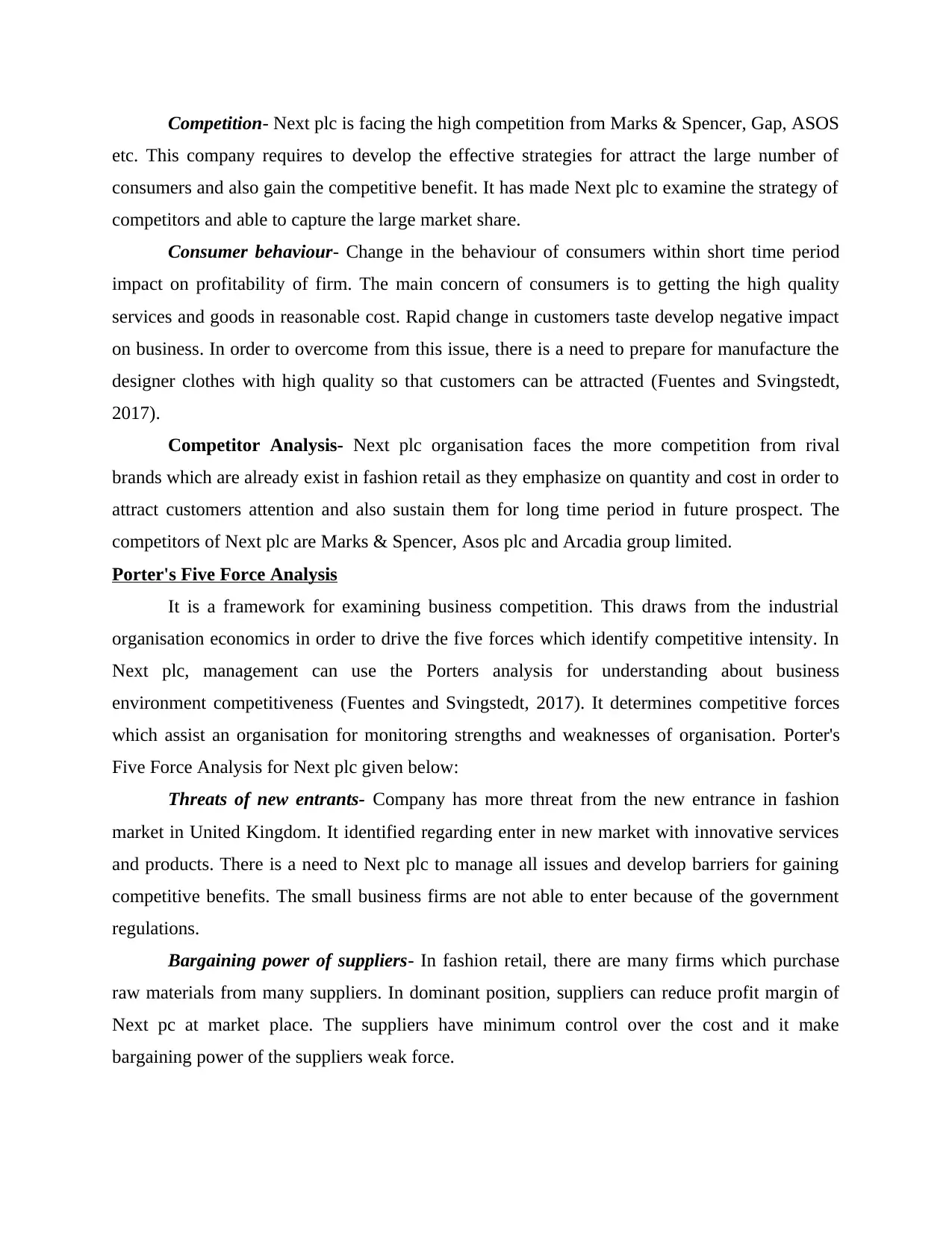
Competition- Next plc is facing the high competition from Marks & Spencer, Gap, ASOS
etc. This company requires to develop the effective strategies for attract the large number of
consumers and also gain the competitive benefit. It has made Next plc to examine the strategy of
competitors and able to capture the large market share.
Consumer behaviour- Change in the behaviour of consumers within short time period
impact on profitability of firm. The main concern of consumers is to getting the high quality
services and goods in reasonable cost. Rapid change in customers taste develop negative impact
on business. In order to overcome from this issue, there is a need to prepare for manufacture the
designer clothes with high quality so that customers can be attracted (Fuentes and Svingstedt,
2017).
Competitor Analysis- Next plc organisation faces the more competition from rival
brands which are already exist in fashion retail as they emphasize on quantity and cost in order to
attract customers attention and also sustain them for long time period in future prospect. The
competitors of Next plc are Marks & Spencer, Asos plc and Arcadia group limited.
Porter's Five Force Analysis
It is a framework for examining business competition. This draws from the industrial
organisation economics in order to drive the five forces which identify competitive intensity. In
Next plc, management can use the Porters analysis for understanding about business
environment competitiveness (Fuentes and Svingstedt, 2017). It determines competitive forces
which assist an organisation for monitoring strengths and weaknesses of organisation. Porter's
Five Force Analysis for Next plc given below:
Threats of new entrants- Company has more threat from the new entrance in fashion
market in United Kingdom. It identified regarding enter in new market with innovative services
and products. There is a need to Next plc to manage all issues and develop barriers for gaining
competitive benefits. The small business firms are not able to enter because of the government
regulations.
Bargaining power of suppliers- In fashion retail, there are many firms which purchase
raw materials from many suppliers. In dominant position, suppliers can reduce profit margin of
Next pc at market place. The suppliers have minimum control over the cost and it make
bargaining power of the suppliers weak force.
etc. This company requires to develop the effective strategies for attract the large number of
consumers and also gain the competitive benefit. It has made Next plc to examine the strategy of
competitors and able to capture the large market share.
Consumer behaviour- Change in the behaviour of consumers within short time period
impact on profitability of firm. The main concern of consumers is to getting the high quality
services and goods in reasonable cost. Rapid change in customers taste develop negative impact
on business. In order to overcome from this issue, there is a need to prepare for manufacture the
designer clothes with high quality so that customers can be attracted (Fuentes and Svingstedt,
2017).
Competitor Analysis- Next plc organisation faces the more competition from rival
brands which are already exist in fashion retail as they emphasize on quantity and cost in order to
attract customers attention and also sustain them for long time period in future prospect. The
competitors of Next plc are Marks & Spencer, Asos plc and Arcadia group limited.
Porter's Five Force Analysis
It is a framework for examining business competition. This draws from the industrial
organisation economics in order to drive the five forces which identify competitive intensity. In
Next plc, management can use the Porters analysis for understanding about business
environment competitiveness (Fuentes and Svingstedt, 2017). It determines competitive forces
which assist an organisation for monitoring strengths and weaknesses of organisation. Porter's
Five Force Analysis for Next plc given below:
Threats of new entrants- Company has more threat from the new entrance in fashion
market in United Kingdom. It identified regarding enter in new market with innovative services
and products. There is a need to Next plc to manage all issues and develop barriers for gaining
competitive benefits. The small business firms are not able to enter because of the government
regulations.
Bargaining power of suppliers- In fashion retail, there are many firms which purchase
raw materials from many suppliers. In dominant position, suppliers can reduce profit margin of
Next pc at market place. The suppliers have minimum control over the cost and it make
bargaining power of the suppliers weak force.
⊘ This is a preview!⊘
Do you want full access?
Subscribe today to unlock all pages.

Trusted by 1+ million students worldwide
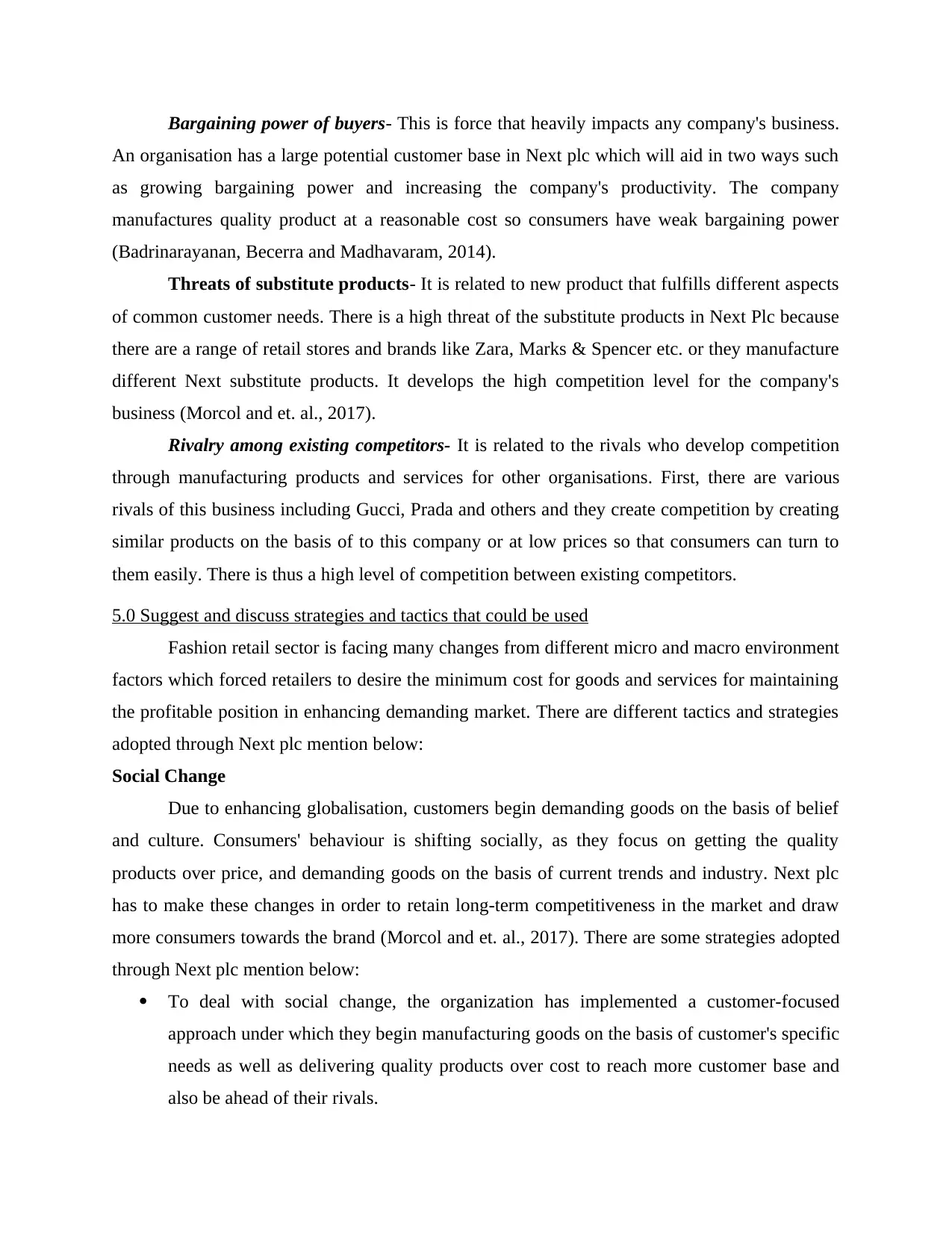
Bargaining power of buyers- This is force that heavily impacts any company's business.
An organisation has a large potential customer base in Next plc which will aid in two ways such
as growing bargaining power and increasing the company's productivity. The company
manufactures quality product at a reasonable cost so consumers have weak bargaining power
(Badrinarayanan, Becerra and Madhavaram, 2014).
Threats of substitute products- It is related to new product that fulfills different aspects
of common customer needs. There is a high threat of the substitute products in Next Plc because
there are a range of retail stores and brands like Zara, Marks & Spencer etc. or they manufacture
different Next substitute products. It develops the high competition level for the company's
business (Morcol and et. al., 2017).
Rivalry among existing competitors- It is related to the rivals who develop competition
through manufacturing products and services for other organisations. First, there are various
rivals of this business including Gucci, Prada and others and they create competition by creating
similar products on the basis of to this company or at low prices so that consumers can turn to
them easily. There is thus a high level of competition between existing competitors.
5.0 Suggest and discuss strategies and tactics that could be used
Fashion retail sector is facing many changes from different micro and macro environment
factors which forced retailers to desire the minimum cost for goods and services for maintaining
the profitable position in enhancing demanding market. There are different tactics and strategies
adopted through Next plc mention below:
Social Change
Due to enhancing globalisation, customers begin demanding goods on the basis of belief
and culture. Consumers' behaviour is shifting socially, as they focus on getting the quality
products over price, and demanding goods on the basis of current trends and industry. Next plc
has to make these changes in order to retain long-term competitiveness in the market and draw
more consumers towards the brand (Morcol and et. al., 2017). There are some strategies adopted
through Next plc mention below:
To deal with social change, the organization has implemented a customer-focused
approach under which they begin manufacturing goods on the basis of customer's specific
needs as well as delivering quality products over cost to reach more customer base and
also be ahead of their rivals.
An organisation has a large potential customer base in Next plc which will aid in two ways such
as growing bargaining power and increasing the company's productivity. The company
manufactures quality product at a reasonable cost so consumers have weak bargaining power
(Badrinarayanan, Becerra and Madhavaram, 2014).
Threats of substitute products- It is related to new product that fulfills different aspects
of common customer needs. There is a high threat of the substitute products in Next Plc because
there are a range of retail stores and brands like Zara, Marks & Spencer etc. or they manufacture
different Next substitute products. It develops the high competition level for the company's
business (Morcol and et. al., 2017).
Rivalry among existing competitors- It is related to the rivals who develop competition
through manufacturing products and services for other organisations. First, there are various
rivals of this business including Gucci, Prada and others and they create competition by creating
similar products on the basis of to this company or at low prices so that consumers can turn to
them easily. There is thus a high level of competition between existing competitors.
5.0 Suggest and discuss strategies and tactics that could be used
Fashion retail sector is facing many changes from different micro and macro environment
factors which forced retailers to desire the minimum cost for goods and services for maintaining
the profitable position in enhancing demanding market. There are different tactics and strategies
adopted through Next plc mention below:
Social Change
Due to enhancing globalisation, customers begin demanding goods on the basis of belief
and culture. Consumers' behaviour is shifting socially, as they focus on getting the quality
products over price, and demanding goods on the basis of current trends and industry. Next plc
has to make these changes in order to retain long-term competitiveness in the market and draw
more consumers towards the brand (Morcol and et. al., 2017). There are some strategies adopted
through Next plc mention below:
To deal with social change, the organization has implemented a customer-focused
approach under which they begin manufacturing goods on the basis of customer's specific
needs as well as delivering quality products over cost to reach more customer base and
also be ahead of their rivals.
Paraphrase This Document
Need a fresh take? Get an instant paraphrase of this document with our AI Paraphraser
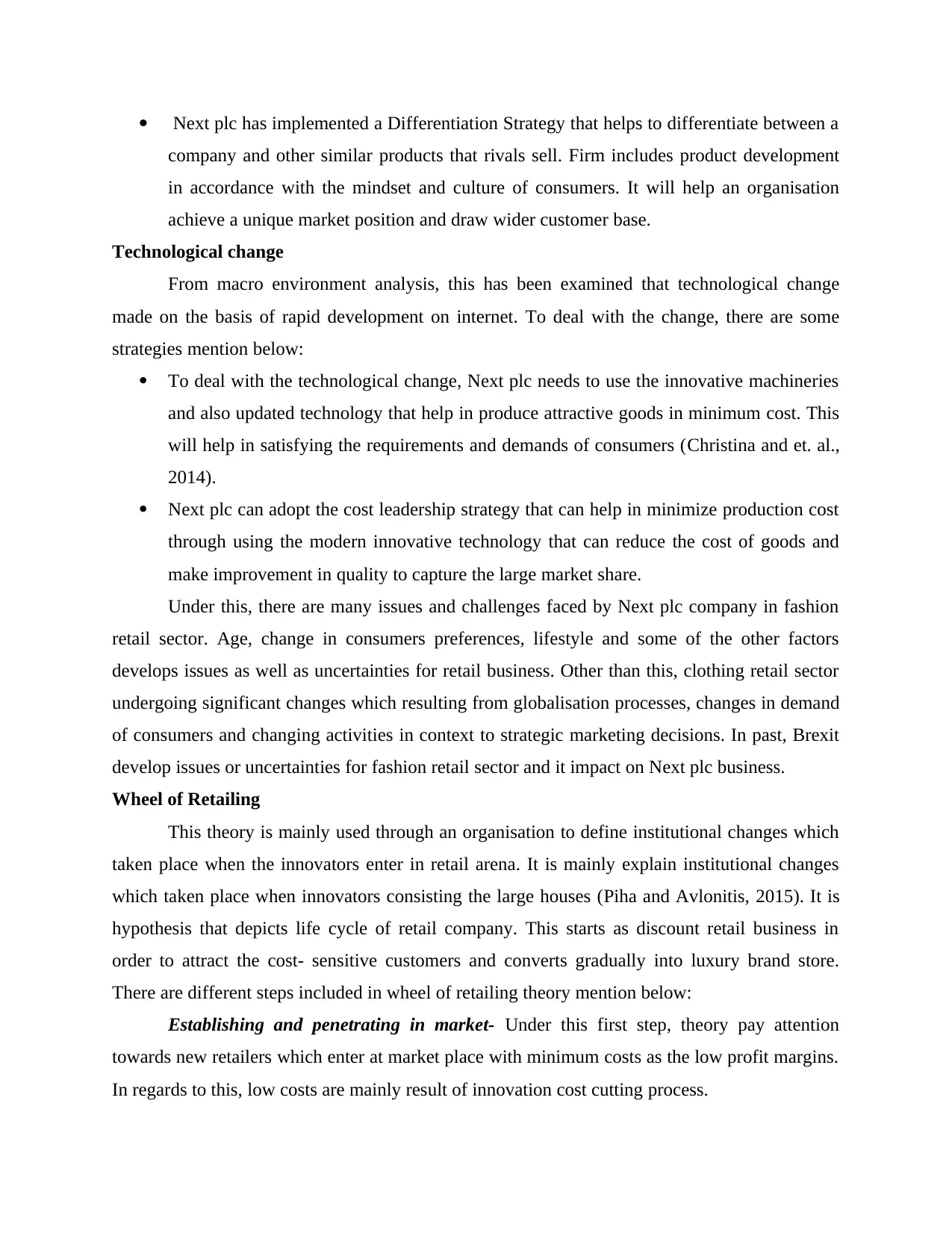
Next plc has implemented a Differentiation Strategy that helps to differentiate between a
company and other similar products that rivals sell. Firm includes product development
in accordance with the mindset and culture of consumers. It will help an organisation
achieve a unique market position and draw wider customer base.
Technological change
From macro environment analysis, this has been examined that technological change
made on the basis of rapid development on internet. To deal with the change, there are some
strategies mention below:
To deal with the technological change, Next plc needs to use the innovative machineries
and also updated technology that help in produce attractive goods in minimum cost. This
will help in satisfying the requirements and demands of consumers (Christina and et. al.,
2014).
Next plc can adopt the cost leadership strategy that can help in minimize production cost
through using the modern innovative technology that can reduce the cost of goods and
make improvement in quality to capture the large market share.
Under this, there are many issues and challenges faced by Next plc company in fashion
retail sector. Age, change in consumers preferences, lifestyle and some of the other factors
develops issues as well as uncertainties for retail business. Other than this, clothing retail sector
undergoing significant changes which resulting from globalisation processes, changes in demand
of consumers and changing activities in context to strategic marketing decisions. In past, Brexit
develop issues or uncertainties for fashion retail sector and it impact on Next plc business.
Wheel of Retailing
This theory is mainly used through an organisation to define institutional changes which
taken place when the innovators enter in retail arena. It is mainly explain institutional changes
which taken place when innovators consisting the large houses (Piha and Avlonitis, 2015). It is
hypothesis that depicts life cycle of retail company. This starts as discount retail business in
order to attract the cost- sensitive customers and converts gradually into luxury brand store.
There are different steps included in wheel of retailing theory mention below:
Establishing and penetrating in market- Under this first step, theory pay attention
towards new retailers which enter at market place with minimum costs as the low profit margins.
In regards to this, low costs are mainly result of innovation cost cutting process.
company and other similar products that rivals sell. Firm includes product development
in accordance with the mindset and culture of consumers. It will help an organisation
achieve a unique market position and draw wider customer base.
Technological change
From macro environment analysis, this has been examined that technological change
made on the basis of rapid development on internet. To deal with the change, there are some
strategies mention below:
To deal with the technological change, Next plc needs to use the innovative machineries
and also updated technology that help in produce attractive goods in minimum cost. This
will help in satisfying the requirements and demands of consumers (Christina and et. al.,
2014).
Next plc can adopt the cost leadership strategy that can help in minimize production cost
through using the modern innovative technology that can reduce the cost of goods and
make improvement in quality to capture the large market share.
Under this, there are many issues and challenges faced by Next plc company in fashion
retail sector. Age, change in consumers preferences, lifestyle and some of the other factors
develops issues as well as uncertainties for retail business. Other than this, clothing retail sector
undergoing significant changes which resulting from globalisation processes, changes in demand
of consumers and changing activities in context to strategic marketing decisions. In past, Brexit
develop issues or uncertainties for fashion retail sector and it impact on Next plc business.
Wheel of Retailing
This theory is mainly used through an organisation to define institutional changes which
taken place when the innovators enter in retail arena. It is mainly explain institutional changes
which taken place when innovators consisting the large houses (Piha and Avlonitis, 2015). It is
hypothesis that depicts life cycle of retail company. This starts as discount retail business in
order to attract the cost- sensitive customers and converts gradually into luxury brand store.
There are different steps included in wheel of retailing theory mention below:
Establishing and penetrating in market- Under this first step, theory pay attention
towards new retailers which enter at market place with minimum costs as the low profit margins.
In regards to this, low costs are mainly result of innovation cost cutting process.
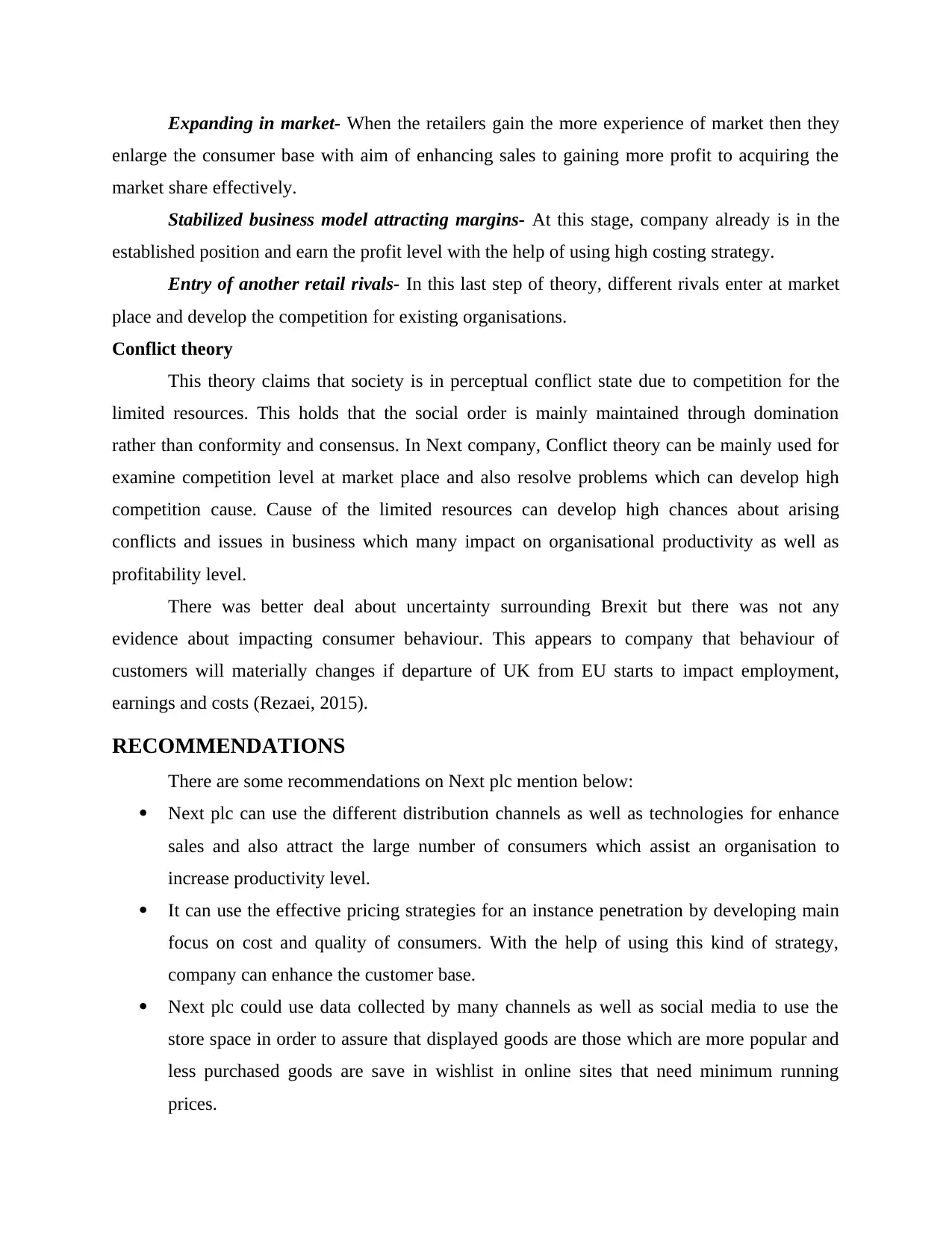
Expanding in market- When the retailers gain the more experience of market then they
enlarge the consumer base with aim of enhancing sales to gaining more profit to acquiring the
market share effectively.
Stabilized business model attracting margins- At this stage, company already is in the
established position and earn the profit level with the help of using high costing strategy.
Entry of another retail rivals- In this last step of theory, different rivals enter at market
place and develop the competition for existing organisations.
Conflict theory
This theory claims that society is in perceptual conflict state due to competition for the
limited resources. This holds that the social order is mainly maintained through domination
rather than conformity and consensus. In Next company, Conflict theory can be mainly used for
examine competition level at market place and also resolve problems which can develop high
competition cause. Cause of the limited resources can develop high chances about arising
conflicts and issues in business which many impact on organisational productivity as well as
profitability level.
There was better deal about uncertainty surrounding Brexit but there was not any
evidence about impacting consumer behaviour. This appears to company that behaviour of
customers will materially changes if departure of UK from EU starts to impact employment,
earnings and costs (Rezaei, 2015).
RECOMMENDATIONS
There are some recommendations on Next plc mention below:
Next plc can use the different distribution channels as well as technologies for enhance
sales and also attract the large number of consumers which assist an organisation to
increase productivity level.
It can use the effective pricing strategies for an instance penetration by developing main
focus on cost and quality of consumers. With the help of using this kind of strategy,
company can enhance the customer base.
Next plc could use data collected by many channels as well as social media to use the
store space in order to assure that displayed goods are those which are more popular and
less purchased goods are save in wishlist in online sites that need minimum running
prices.
enlarge the consumer base with aim of enhancing sales to gaining more profit to acquiring the
market share effectively.
Stabilized business model attracting margins- At this stage, company already is in the
established position and earn the profit level with the help of using high costing strategy.
Entry of another retail rivals- In this last step of theory, different rivals enter at market
place and develop the competition for existing organisations.
Conflict theory
This theory claims that society is in perceptual conflict state due to competition for the
limited resources. This holds that the social order is mainly maintained through domination
rather than conformity and consensus. In Next company, Conflict theory can be mainly used for
examine competition level at market place and also resolve problems which can develop high
competition cause. Cause of the limited resources can develop high chances about arising
conflicts and issues in business which many impact on organisational productivity as well as
profitability level.
There was better deal about uncertainty surrounding Brexit but there was not any
evidence about impacting consumer behaviour. This appears to company that behaviour of
customers will materially changes if departure of UK from EU starts to impact employment,
earnings and costs (Rezaei, 2015).
RECOMMENDATIONS
There are some recommendations on Next plc mention below:
Next plc can use the different distribution channels as well as technologies for enhance
sales and also attract the large number of consumers which assist an organisation to
increase productivity level.
It can use the effective pricing strategies for an instance penetration by developing main
focus on cost and quality of consumers. With the help of using this kind of strategy,
company can enhance the customer base.
Next plc could use data collected by many channels as well as social media to use the
store space in order to assure that displayed goods are those which are more popular and
less purchased goods are save in wishlist in online sites that need minimum running
prices.
⊘ This is a preview!⊘
Do you want full access?
Subscribe today to unlock all pages.

Trusted by 1+ million students worldwide
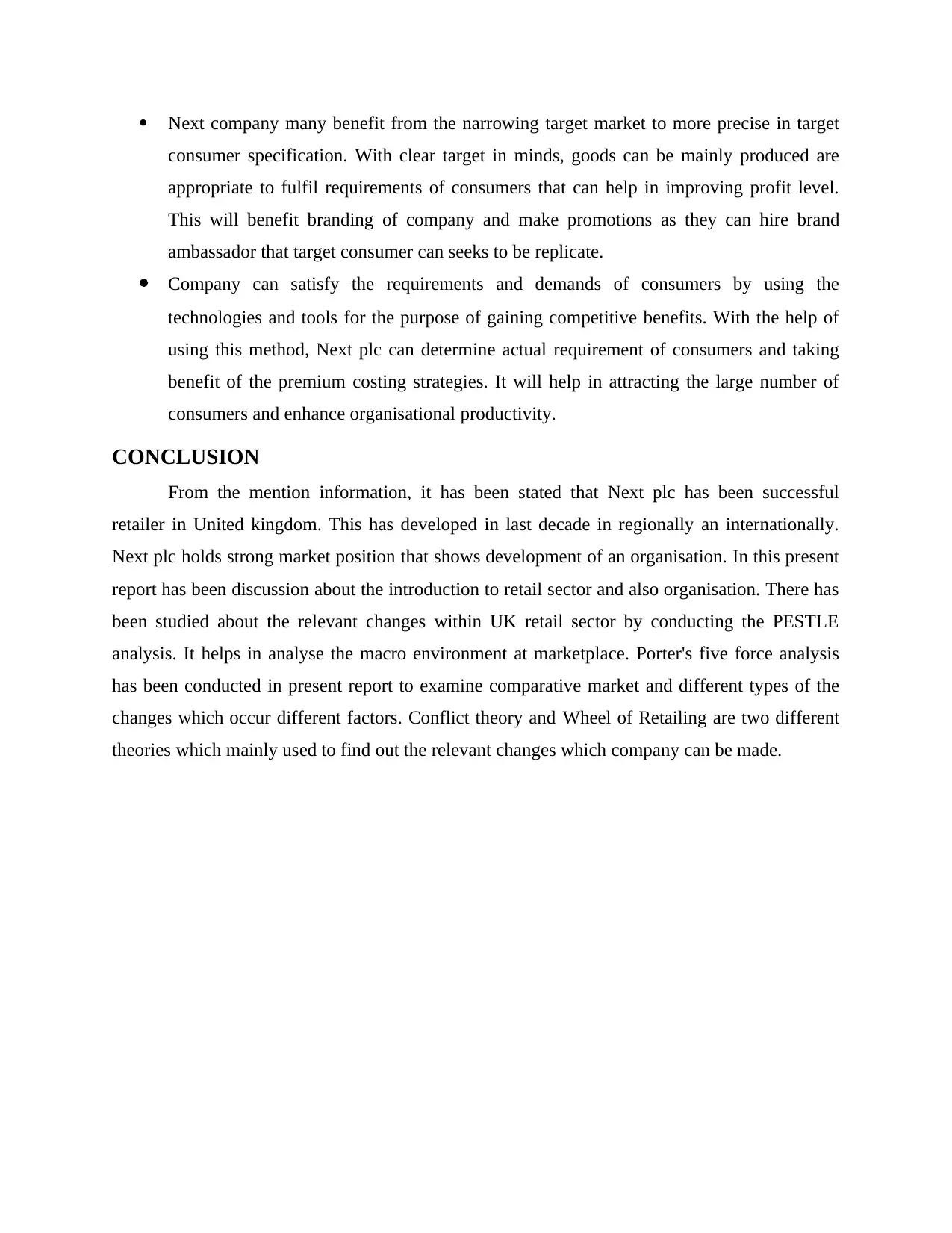
Next company many benefit from the narrowing target market to more precise in target
consumer specification. With clear target in minds, goods can be mainly produced are
appropriate to fulfil requirements of consumers that can help in improving profit level.
This will benefit branding of company and make promotions as they can hire brand
ambassador that target consumer can seeks to be replicate.
Company can satisfy the requirements and demands of consumers by using the
technologies and tools for the purpose of gaining competitive benefits. With the help of
using this method, Next plc can determine actual requirement of consumers and taking
benefit of the premium costing strategies. It will help in attracting the large number of
consumers and enhance organisational productivity.
CONCLUSION
From the mention information, it has been stated that Next plc has been successful
retailer in United kingdom. This has developed in last decade in regionally an internationally.
Next plc holds strong market position that shows development of an organisation. In this present
report has been discussion about the introduction to retail sector and also organisation. There has
been studied about the relevant changes within UK retail sector by conducting the PESTLE
analysis. It helps in analyse the macro environment at marketplace. Porter's five force analysis
has been conducted in present report to examine comparative market and different types of the
changes which occur different factors. Conflict theory and Wheel of Retailing are two different
theories which mainly used to find out the relevant changes which company can be made.
consumer specification. With clear target in minds, goods can be mainly produced are
appropriate to fulfil requirements of consumers that can help in improving profit level.
This will benefit branding of company and make promotions as they can hire brand
ambassador that target consumer can seeks to be replicate.
Company can satisfy the requirements and demands of consumers by using the
technologies and tools for the purpose of gaining competitive benefits. With the help of
using this method, Next plc can determine actual requirement of consumers and taking
benefit of the premium costing strategies. It will help in attracting the large number of
consumers and enhance organisational productivity.
CONCLUSION
From the mention information, it has been stated that Next plc has been successful
retailer in United kingdom. This has developed in last decade in regionally an internationally.
Next plc holds strong market position that shows development of an organisation. In this present
report has been discussion about the introduction to retail sector and also organisation. There has
been studied about the relevant changes within UK retail sector by conducting the PESTLE
analysis. It helps in analyse the macro environment at marketplace. Porter's five force analysis
has been conducted in present report to examine comparative market and different types of the
changes which occur different factors. Conflict theory and Wheel of Retailing are two different
theories which mainly used to find out the relevant changes which company can be made.
Paraphrase This Document
Need a fresh take? Get an instant paraphrase of this document with our AI Paraphraser
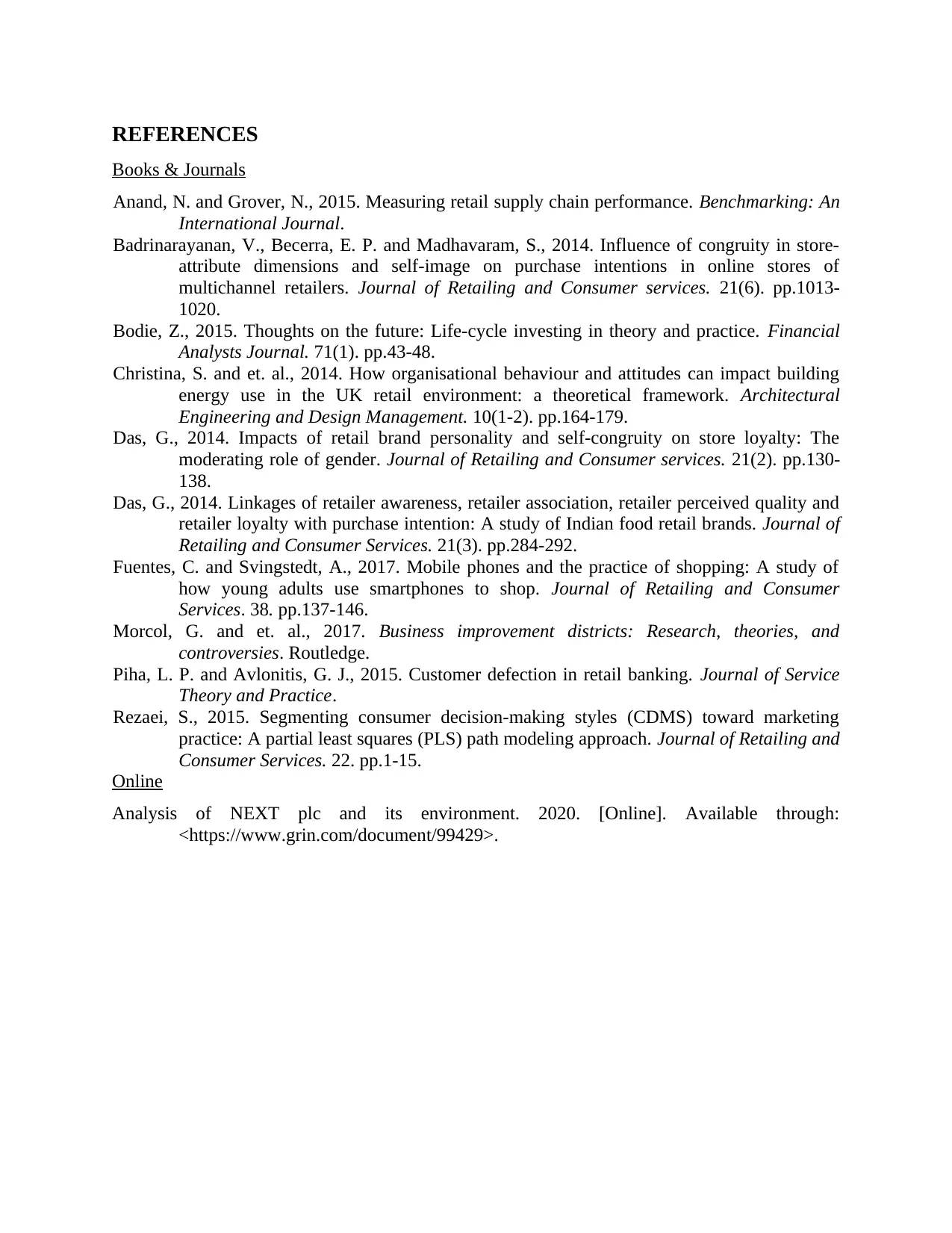
REFERENCES
Books & Journals
Anand, N. and Grover, N., 2015. Measuring retail supply chain performance. Benchmarking: An
International Journal.
Badrinarayanan, V., Becerra, E. P. and Madhavaram, S., 2014. Influence of congruity in store-
attribute dimensions and self-image on purchase intentions in online stores of
multichannel retailers. Journal of Retailing and Consumer services. 21(6). pp.1013-
1020.
Bodie, Z., 2015. Thoughts on the future: Life-cycle investing in theory and practice. Financial
Analysts Journal. 71(1). pp.43-48.
Christina, S. and et. al., 2014. How organisational behaviour and attitudes can impact building
energy use in the UK retail environment: a theoretical framework. Architectural
Engineering and Design Management. 10(1-2). pp.164-179.
Das, G., 2014. Impacts of retail brand personality and self-congruity on store loyalty: The
moderating role of gender. Journal of Retailing and Consumer services. 21(2). pp.130-
138.
Das, G., 2014. Linkages of retailer awareness, retailer association, retailer perceived quality and
retailer loyalty with purchase intention: A study of Indian food retail brands. Journal of
Retailing and Consumer Services. 21(3). pp.284-292.
Fuentes, C. and Svingstedt, A., 2017. Mobile phones and the practice of shopping: A study of
how young adults use smartphones to shop. Journal of Retailing and Consumer
Services. 38. pp.137-146.
Morcol, G. and et. al., 2017. Business improvement districts: Research, theories, and
controversies. Routledge.
Piha, L. P. and Avlonitis, G. J., 2015. Customer defection in retail banking. Journal of Service
Theory and Practice.
Rezaei, S., 2015. Segmenting consumer decision-making styles (CDMS) toward marketing
practice: A partial least squares (PLS) path modeling approach. Journal of Retailing and
Consumer Services. 22. pp.1-15.
Online
Analysis of NEXT plc and its environment. 2020. [Online]. Available through:
<https://www.grin.com/document/99429>.
Books & Journals
Anand, N. and Grover, N., 2015. Measuring retail supply chain performance. Benchmarking: An
International Journal.
Badrinarayanan, V., Becerra, E. P. and Madhavaram, S., 2014. Influence of congruity in store-
attribute dimensions and self-image on purchase intentions in online stores of
multichannel retailers. Journal of Retailing and Consumer services. 21(6). pp.1013-
1020.
Bodie, Z., 2015. Thoughts on the future: Life-cycle investing in theory and practice. Financial
Analysts Journal. 71(1). pp.43-48.
Christina, S. and et. al., 2014. How organisational behaviour and attitudes can impact building
energy use in the UK retail environment: a theoretical framework. Architectural
Engineering and Design Management. 10(1-2). pp.164-179.
Das, G., 2014. Impacts of retail brand personality and self-congruity on store loyalty: The
moderating role of gender. Journal of Retailing and Consumer services. 21(2). pp.130-
138.
Das, G., 2014. Linkages of retailer awareness, retailer association, retailer perceived quality and
retailer loyalty with purchase intention: A study of Indian food retail brands. Journal of
Retailing and Consumer Services. 21(3). pp.284-292.
Fuentes, C. and Svingstedt, A., 2017. Mobile phones and the practice of shopping: A study of
how young adults use smartphones to shop. Journal of Retailing and Consumer
Services. 38. pp.137-146.
Morcol, G. and et. al., 2017. Business improvement districts: Research, theories, and
controversies. Routledge.
Piha, L. P. and Avlonitis, G. J., 2015. Customer defection in retail banking. Journal of Service
Theory and Practice.
Rezaei, S., 2015. Segmenting consumer decision-making styles (CDMS) toward marketing
practice: A partial least squares (PLS) path modeling approach. Journal of Retailing and
Consumer Services. 22. pp.1-15.
Online
Analysis of NEXT plc and its environment. 2020. [Online]. Available through:
<https://www.grin.com/document/99429>.

10
⊘ This is a preview!⊘
Do you want full access?
Subscribe today to unlock all pages.

Trusted by 1+ million students worldwide
1 out of 12
Related Documents
Your All-in-One AI-Powered Toolkit for Academic Success.
+13062052269
info@desklib.com
Available 24*7 on WhatsApp / Email
![[object Object]](/_next/static/media/star-bottom.7253800d.svg)
Unlock your academic potential
Copyright © 2020–2025 A2Z Services. All Rights Reserved. Developed and managed by ZUCOL.




